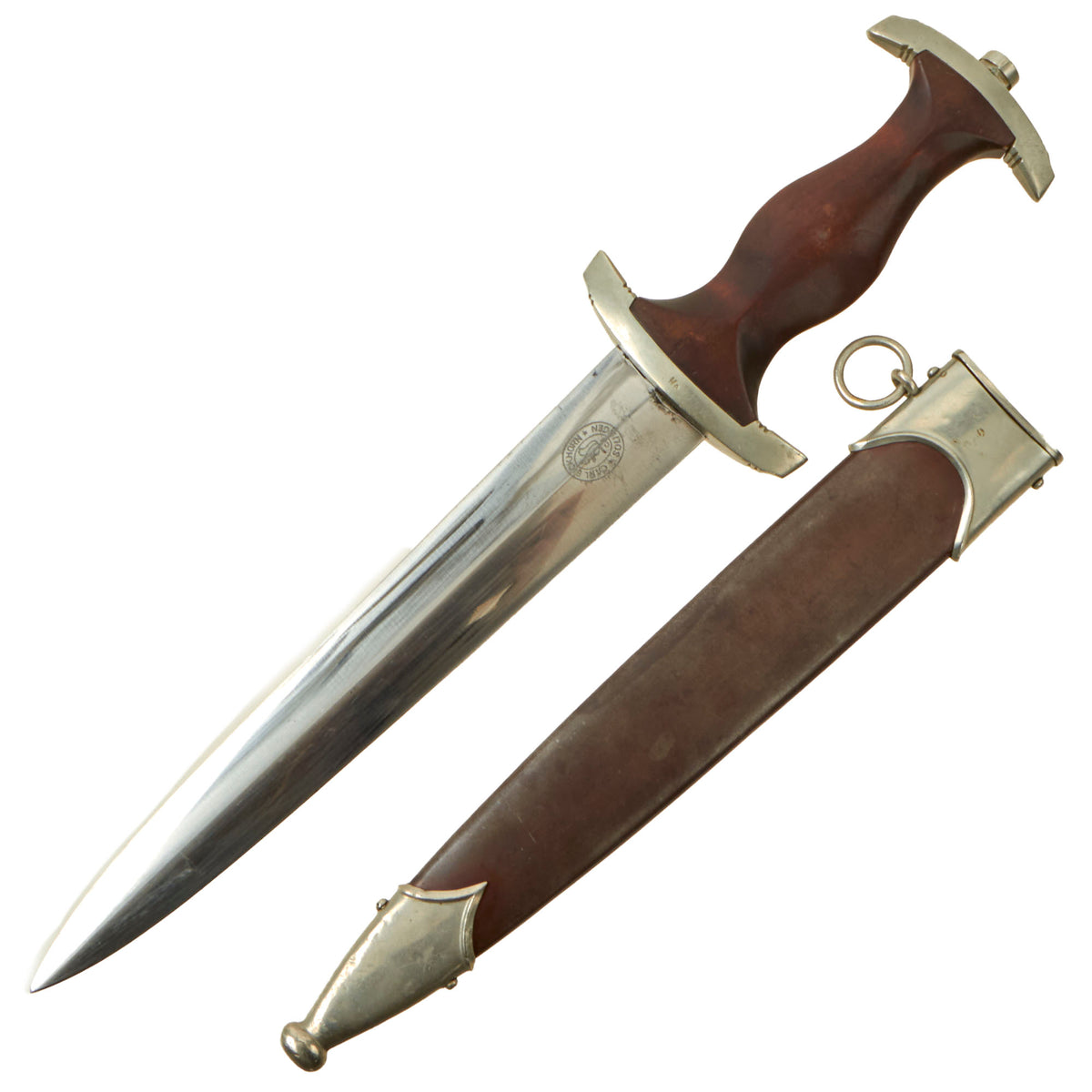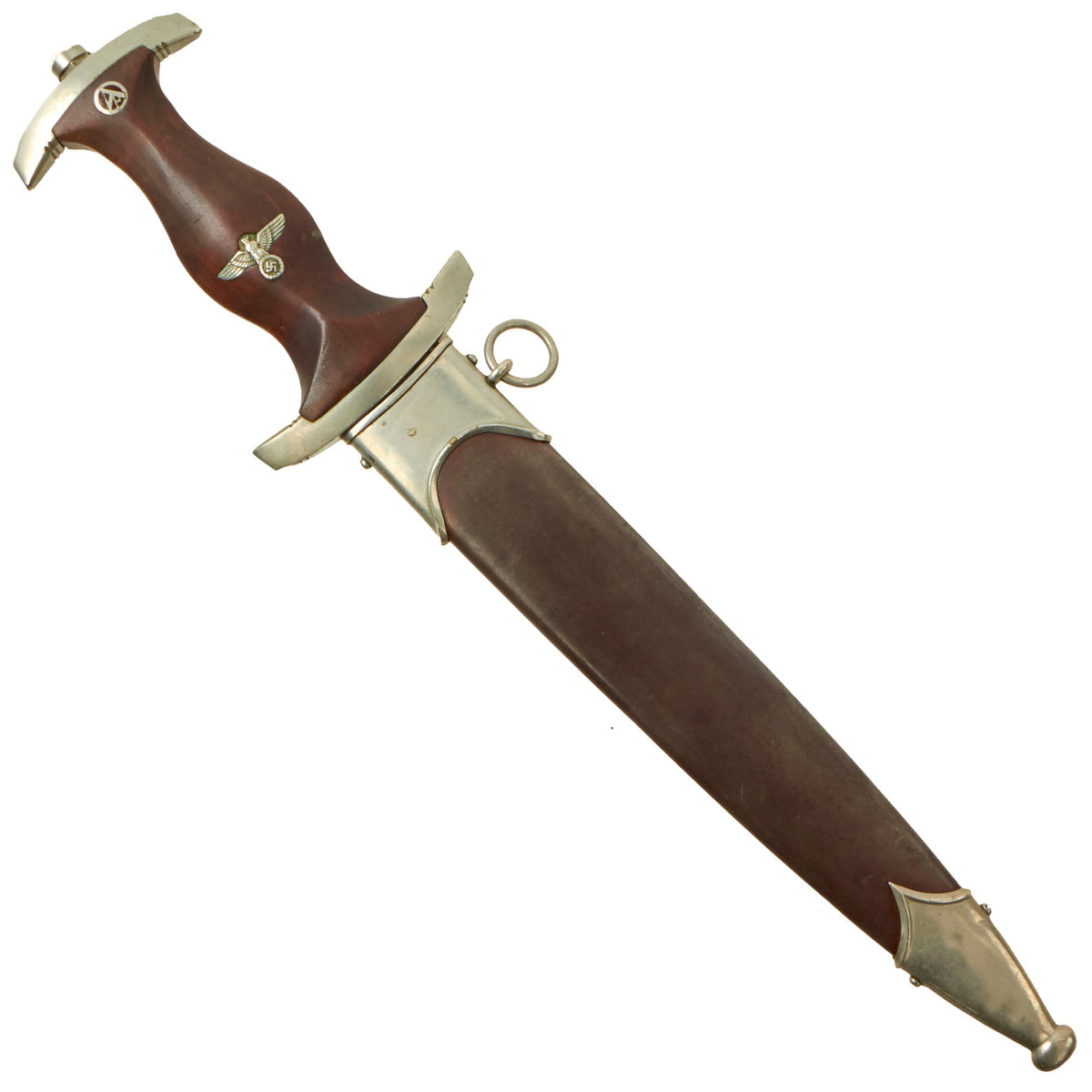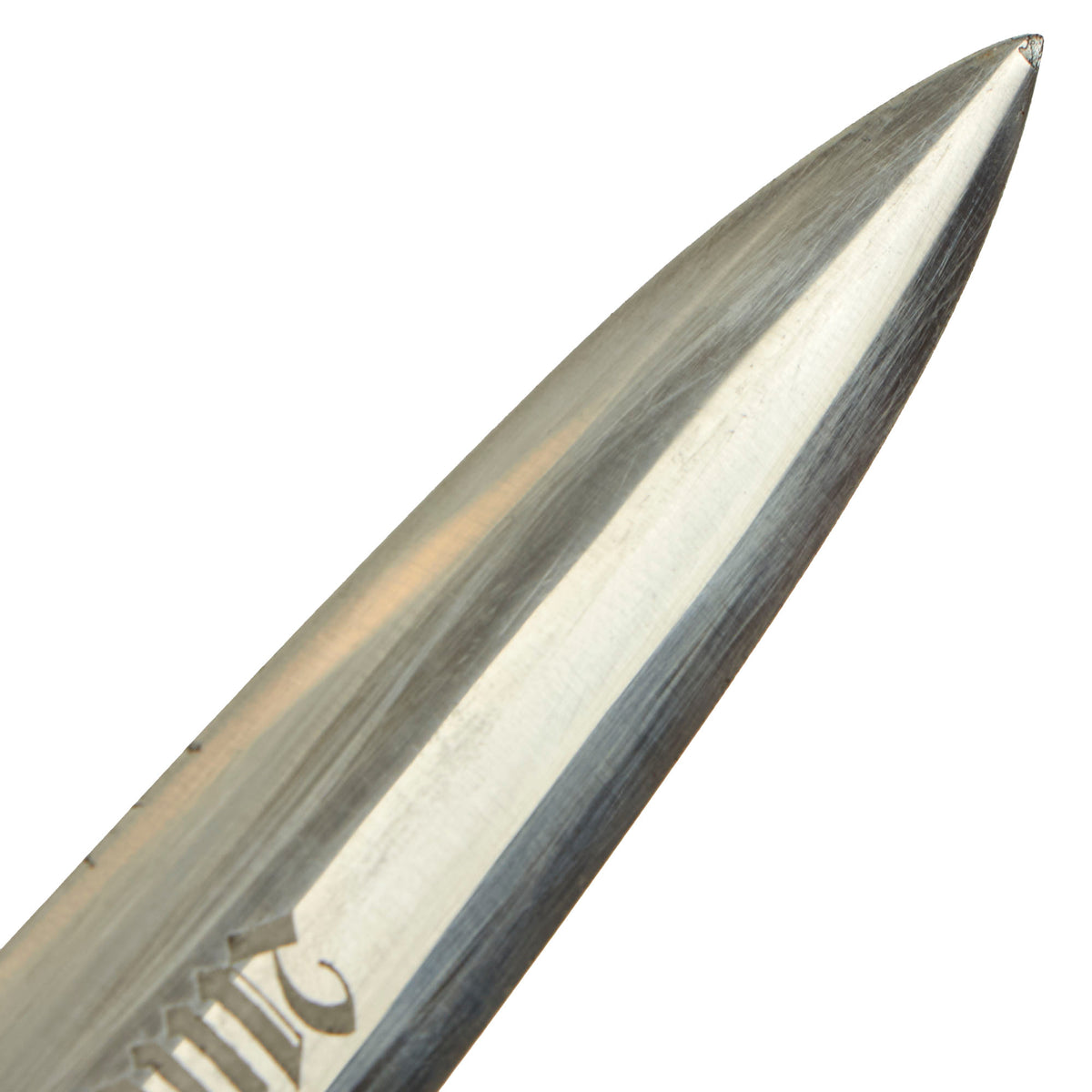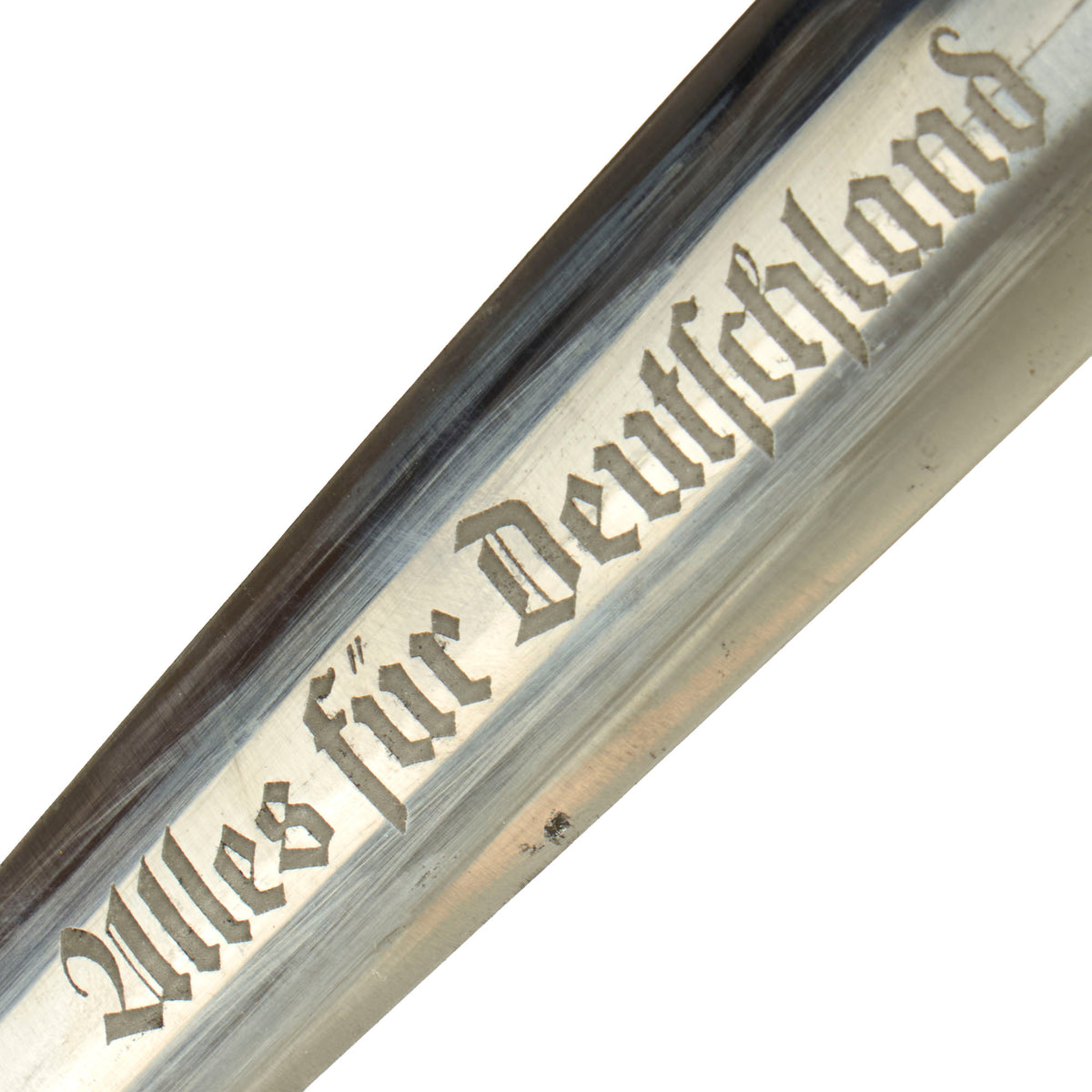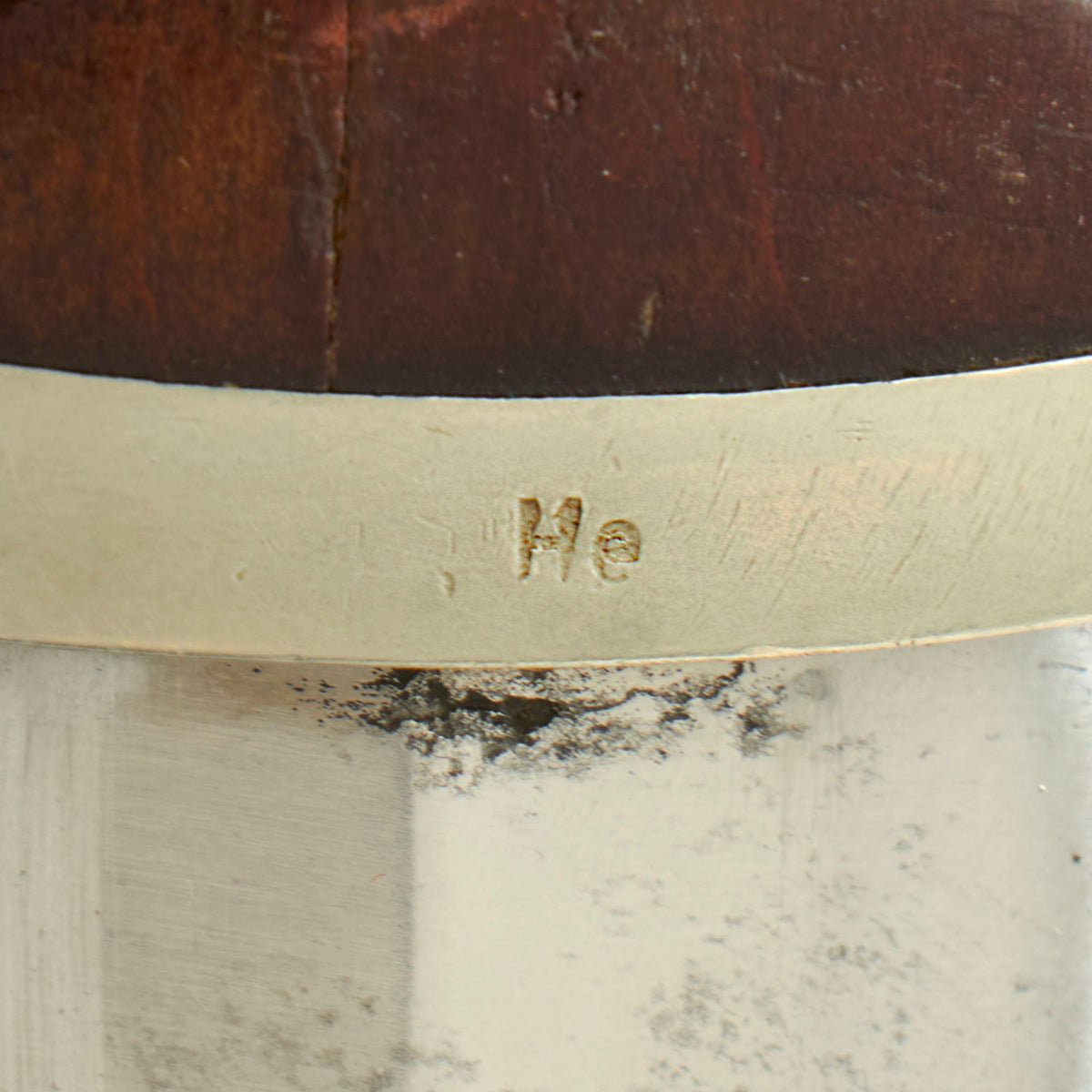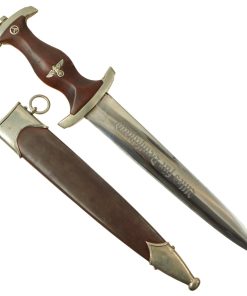Original German WWII Early SA Dagger by Carl Eickhorn of Solingen with Scabbard – 1933-1935 Trademark Original Items
$ 1.195,00 $ 298,75
Original Item: Only One Available. This is a lovely condition early pattern SA Dienstdolch (Service Dagger) with a beautiful blade, made by the legendary firm Carl Eickhorn of Solingen. It comes comes compete with an original early production anodized scabbard, which is in very nice condition.
The dagger has solid nickel silver fittings throughout, and is a great example with a lovely look. The crossguards and tang nut are in very good condition throughout with all fittings having a nice lightly aged patina. There is just a bit of age to these mounts but there is no lifting anywhere, showing that they are solid and not plated. They show only light wear with just a bit of light denting and scratching, and do look to have been cleaned a bit over the years. The lower reverse guard is Gruppe/Gau marked He, for Hessen, a district in the west of Germany, with the principal city being Frankfurt. This feature was only seen on daggers produced 1935 and prior.
The grip is a fine product having a lovely dark red brown mahogany color, with medium center ridge construction, showing only light wear with a few small dents and some cracking. The wood is still in very good condition, with some great color variation, and fits the crossguards nicely. There are some small cracks on either side of the cross guard, running about 1/2 inch inward. running through the symbol, which is quite common. The pommel nut does show some turning on the outside, and the grip is still tightly secured, with no wiggle. The SA symbol button is nicely set, with the translucent enamel is almost fully intact, though there definitely is wear to the metal of the insignia. The grip eagle is a fine example being the style with beak that points straight. It has just a bit of verdigris on it, showing that it is solid nickel alloy, and it has patinated nicely. The details are still there to the eagle to include the beak, breast feathering, wing feathering, talons, wreath and mobile swas (hook cross).
The blade is in very good condition and bright, still showing almost all of the original factory final grind cross grain on both sides! This texture is iconic, and is the definitive identifying characteristic for a real WWII German Blade. It shows some signs of light cleaning, but the grain is still present in most areas, except where the runners have worn it smooth. There are few tiny spots of oxidation and staining, with no major rust issues. There is also some damage to the tip of the blade, which may have been reprofiled a bit. The edge is correctly unsharpened, showing just a bit of light oxidation roughness. The acid-etched Alles für Deutschland (Everything for Germany) SA motto is crisp, and the factory darkening is just a bit worn. Definitely a great condition blade!
The rear ricasso of the blade is stamped with the Carl Eickhorn 1933-35 style double oval trademark logo. It features the trademark squirrel looking to the viewer’s left over C.E., surrounded by the first oval. Inside the second oval is CARL EICKHORN above and SOLINGEN below, with stars in between. This is one of several similar but not identical Trademark logos Eickhorn used during this period. According to J. Anthony Carter’s book, GERMAN KNIFE AND SWORD MAKERS, this company was founded in 1865 by Carl Eickhorn, and is arguably the most famous of all Solingen makers. Not only could the family trace their history back 500 years, but they could also demonstrate involvement in the hardening and grinding industries for the same period. Truly the nobility of Solingen Edged weapon dynasties. Eickhorn edged weapons are the most desirable of all makers.
The scabbard shell is straight throughout and is the early-war style, which were produced with a brown “anodized” finish on the steel, which was then lacquered. This example has lost much of the lacquer finish, with traces left near the fittings and scattered on the body. However it still retains much of the original anodized finish, and this is definitely one of the better examples we have seen, with no dents on the body and only light oxidation. The upper and lower fittings are solid nickel silver, with a great look and some dents and scratches showing typical wear. The chape actually shows very little denting, definitely a rarity given how soft the alloy is. The throat nicely matches the crossguards, and all fittings have their original screws.
A lovely early wartime SA dagger with a great blade, made by the most legendary of all Solingen makers, complete with the original scabbard. Ready to display!
Specifications:
Blade Length: 8 3/4″
Overall length: 13 3/4”
Crossguard: 3”
Scabbard Length: 10”
History of the SA-
The SA or Brown Shirts, were a private political formation which Adolf AH and the NSDAP used to maintain order at organized Party meetings and demonstrations. The group was formed in 1921, and grew to a huge force of nearly 3,000,000 men by the later 1930’s. To instill esprit de corps, as well as create employment for the Blade City of Solingen, it was decided each SA man would carry a dagger with his Brown Shirt uniform. Huge quantities needed to be produced to accommodate the demand. The dagger initially was produced of hand-fitted nickel mounts with attractive finished wood grip and brown anodized (a bluing process) finished scabbard.
The blade was etched with the SA motto, Alles für Deutschland. Examples produced prior to 1935 were stamped with the German sector of the SA group on reverse lower crossguard. Later examples underwent standardization through the RZM ministry. These pieces were produced of cheaper plated zinc-base fittings and scabbards were simply painted brown.
Prior to his “unmasking” as a traitor, Ernst Röhm was the leader of the SA. In 1934, he distributed approximately 100,000 SA daggers with his personal inscription on the reverse blade. These daggers were to honor individuals who had served with the SA prior to December, 1931. Other than the inscription, these pieces were identical to the standard M1933 SA dagger. After the Röhm purge, the inscription was ordered to be removed. Many examples were returned to the factory for grinding. Others were simply ground in the field by whatever means were available. Examples will occasionally be encountered with remnants of the original inscription remaining on the blade, but mostly none will remain. Some blades exist with an intact inscription, reflecting only the removal of the Röhm signature. Very very rarely is an example seen with a full, untouched inscription, as the holder would have surely risked a charge of treason.
Fast Shipping with Professional Packaging
Thanks to our longstanding association with UPS FedEx DHL, and other major international carriers, we are able to provide a range of shipping options. Our warehouse staff is expertly trained and will wrap your products according to our exact and precise specifications. Prior to shipping, your goods will be thoroughly examined and securely secured. We ship to thousands clients each day across multiple countries. This shows how we're dedicated to be the largest retailer on the internet. Warehouses and distribution centres can be located throughout Europe as well as the USA.
Note: Orders with more than one item will be assigned a processing date depending on the item.
Before shipping before shipping, we'll conduct a thorough inspection of the items you have ordered. Today, the majority of orders will be delivered within 48 hours. The delivery time will be between 3-7 days.
Returns
The stock is dynamic and we cannot completely manage it because multiple stakeholders are involved, including our factory and warehouse. So the actual stock may alter at any time. It's possible that you may not receive your order once the order has been made.
Our policy is valid for a period of 30 days. If you don't receive the product within 30 days, we are not able to issue a refund or an exchange.
You can only return an item if it is unused and in the same state as the day you received it. You must have the item in its original packaging.
Related products
Uncategorized
Uncategorized
Uncategorized
Uncategorized
Uncategorized
Armoured Fighting Vehicles of the World: AFVs of World War One (Hardcover Book) New Made Items
Uncategorized
Uncategorized
Uncategorized
Uncategorized
Uncategorized
Uncategorized
Band of Brothers ORIGINAL GERMAN WWII Le. F.H. 18 10.5cm ARTILLERY PIECE Original Items
Uncategorized
Uncategorized
Uncategorized
Armored Burgonet Helmet & Polearm from Scottish Castle Leith Hall Circa 1700 Original Items
Uncategorized
Uncategorized
Uncategorized
Uncategorized
Uncategorized
Uncategorized

